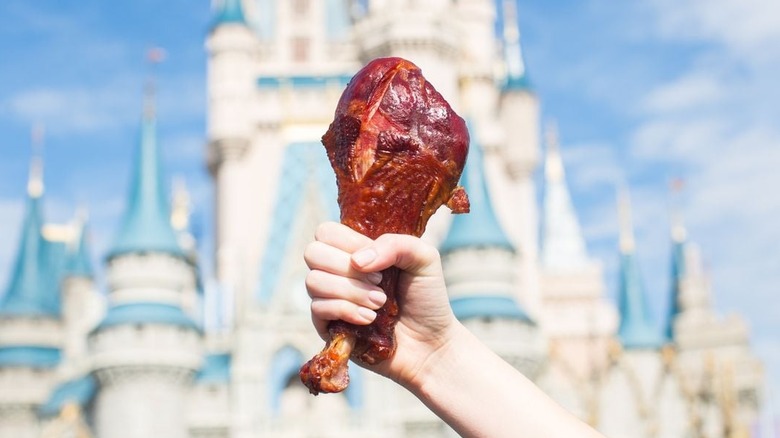Few food items are as polarizing as the turkey leg — it is a true “love it” or “hate it” situation. On one end of the spectrum, its beloved admirers cant get enough of the generously portioned, sodium-laced, portable food. On the other hand, its haters really know how to hate — knocking its large, often grotesque appearance and the astonishing amounts of calories, fat, and God knows what else youre ingesting in one seating. Haters gonna hate, right?
Whether you have tried one or been an innocent bystander, the sight of one has likely been burned into your mind forever. You just cant unsee the thing. The turkey leg has its place in many amusement parks, county fairs, and festivals across the country. Theres even a holiday dedicated to it (okay, all turkey products really) each year when its faithful admirers rally together for National Turkey Lovers Day. On paper, it is a snack — or meal (because, lets be honest, its huge) — comprised mostly of protein from the aforementioned animal. So, why does the bird get so much heat? Join us on this brine-filled adventure of fat, fun, and fairs. This is the untold truth of the turkey leg.
Turkey legs have become a popular snack food, especially at theme parks and festivals. Known for their large size, turkey legs often leave people wondering – why are they so big compared to what you would get on a whole turkey? As a turkey leg enthusiast, I set out to uncover the truth behind their mammoth size.
A Little History
While turkey legs were not actually eaten during medieval times, they became popular fare at Renaissance fairs in the 1960s. The giant turkey leg made its debut at Disneyland and Walt Disney World in the late 1980s. Originally sold from just one food cart in Frontierland, they quickly became a fan favorite.
Other theme parks and festivals followed suit, and the jumbo turkey leg grew into an iconic snack across the country. Annual sales at Disney’s parks alone top 2 million turkey legs! They’ve expanded from a tasty treat to being featured on merchandise and touted as a symbol of Disney’s parks.
Why So Big?
There are two main reasons turkey legs at theme parks are substantially larger than those on a whole roast turkey
1. They come from male turkeys.
The legs are from tom turkeys, or male turkeys, which are much larger than hens Toms can reach over 40 pounds, while hens average 16 pounds This allows for a turkey leg to weigh around 1.5 pounds.
2. Selective breeding enhances size.
Turkey legs are specifically bred to be bigger than those on commercially raised birds. Turkey suppliers that provide Disney’s parks look for the biggest, meatiest legs they can find. Through selective breeding, the supplier has created turkey legs that are nearly double the typical roasted turkey leg.
Questionable Contents
The giant turkey leg’s contents have come under scrutiny over the years. Some key facts:
-
It is 100% turkey meat – contrary to rumors, it does not contain emu, ostrich or other meats. The strong cured flavor leads some to think it’s ham.
-
Salt content is high – turkey legs are cured in a salt solution giving them a ham-like flavor. One leg has over 5,000 mg of sodium.
-
High in fat and calories – estimated to have 720 calories and 36 grams of fat due to the curing process and an entire leg’s worth of meat.
While the turkey legs live up to their reputation as an indulgent, carnival-style snack, they remain a beloved treat for many theme park goers.
Behind the Scenes Secrets
After uncovering the history and science behind their supersized shape, I dug into some insider info on Disney’s famous turkey legs:
-
Cast members report legs must weigh at least 1.5 pounds to meet Disney’s size standards. Legs not meeting the minimum weight are rejected.
-
Over 2 million turkey legs are sold annually across Disney’s parks in Orlando and Anaheim.
-
Select breeding allows suppliers to source turkeys with the largest, meatiest legs to create Disney’s signature snack.
-
Turkey legs used to cost just $9.49 but have risen in price over the years to $12.50 currently.
-
Images of turkey legs have been used by Disney for fun merchandise like t-shirts, boxer shorts and even air fresheners!
-
Disney does not publish exact nutrition info but experts estimate 720 calories and 36 grams of fat per leg.
Why I Love Them
As someone who orders a turkey leg every time I visit a theme park, here’s why I’m a fan:
-
Portable -easy to carry around the park compared to other meat options like ribs.
-
Meaty – lots of juicy, smoked meat in each bite. Far more satisfying than a traditional roasted leg.
-
Flavorful – the cured ham-like taste is bold and addicting.
-
Nostalgic – brings me right back to childhood trips and carnival memories.
-
Shareable – each leg is so big, it can easily be split between 2-3 people.
-
Instagrammable – the visually striking, almost comically large snack makes for a great foodie photo.
Do turkey legs deserve the hype? I say yes! Their unique origin story, hefty proportions, and nostalgic fun make turkey legs a one-of-a-kind treat.

It was a mouse that brought this food global attention

Disney Parks are synonymous with snacks — from their wildly popular (and adorable) Mickey head pretzels and ice cream bars to Insta-worthy limited release cupcakes. Although turkey legs have lived quietly amongst the Renaissance Fair community (and its avid carnivores) since the 1960s, it was the house of the mouse that is credited with making it a household name.
According to a New York Times piece, the turkey leg made its grand debut at Walt Disney World in Central Florida in the 1980s. Fittingly, it appeared first at a food stand next to a coonskin cap retailer in Magic Kingdoms Frontierland. They were a hit instantly with wide-eyed and hungry theme park goers and now turkey legs could be found throughout all of their four parks. It soon made its way across the country to Disneyland and eventually other theme parks across the United States, including Universal Studios, Dollywood, and SeaWorld.
Despite what you may think, they aren’t keto

Keto is a wildly popular diet that has garnered global attention in recent years thanks to a slew of celebrities and major brands hopping on board. Essentially, it is a super low-carb diet that relies on healthy, high-quality proteins and fats to fuel the body, not sugar and complex carbohydrates. On paper, a turkey leg should — in theory— fall under the guidelines. Sorry to say keto dieters, put down the turkey leg immediately.
Smoked meat is inherently a-okay on the diet, but its the popular preparation of the turkey leg that makes this one a big, fat no-no. According to a Reddit thread that deep dives into the recipe in question, the brine used in many popular preparations, including theme parks, has brown sugar in it. Brown sugar is without a doubt not okay on the keto diet. We were able to track down a copycat recipe for Disneys turkey leg and that confirmed our suspicions as over 1 table of dark brown sugar was used in the brine.
